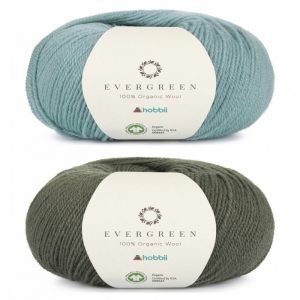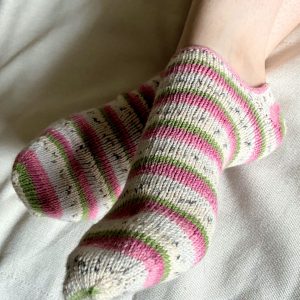The basic idea with the afterthought heel is that the heel isn’t worked until after the main part of the sock is complete. The heel is called peasant or forethought heel if you decide the heel placement while you are knitting the body of the sock and use waste yarn as a placeholder in a planned location.
This heel type is ideal for colorwork socks or socks knitted with self-striping yarn because it does not interrupt the pattern. It can be used also for a perfectly symmetric contrasting color heel.
All you need to know is the number of stitches you have per sock and your row gauge. Based on those numbers this pattern calculates also the placement for your heel. You can easily measure the row gauge after you have finished the toe or leg so there is no need to make a swatch.
This pattern is part of my universal basic sock pattern.
On knitgrammer.com you can find also patterns for german short row heel (toe up or cuff down), flap and gusset heel for toe up socks as well as dutch and french heel for cuff down socks.

The pattern is written for magic loop method, but can be adjusted for dpn’s. Your stitches should be divided evenly on two needles.
sts on my needles rows / 4” (10cm).
Pattern
Beginning your sock from toe, work until your foot measures 2” (5 cm) less than desired length. If you are making your sock cuff down work until your leg measures 2” (5 cm) less than desired length.
Heel placement
- Needle 1: k all sts.
- Needle 2: Take a piece of scrap yarn in a different colour and leaving the working yarn aside, use it to k the sts on Needle 2. Then, transfer all those sts back to the left needle (without twisting) and k over the scrap yarn using the working yarn.
Continue working the sock and start making the heel after you are finished with rest of the sock.
If you are making your sock cuff down your work should measure from scrap yarn to toe desired length minus 2” (5 cm).
Making the heel
Remove the waste yarn, placing the live stitches onto two needles. You should now have a total of 56 sts, 28 sts on each needle.
Round 1
- Needle 1: k all, pickup and knit 2 sts between the Needle 1 and Needle 2
- Needle 2: Work the same way as Needle 1.
TIP: See this very helpful video tutorial of how to pick up stitches for an afterthought heel without any gaps or holes.
You should now have a total of 58 sts divided evenly on two needles.
Round 2
- Needle 1: k1, ssk, k to 3 sts from end, k2tog, k1.
- Needle 2: Work the same way as Needle 1.
Round 3
- Needle 1: k all sts.
- Needle 2: Work the same way as Needle 1.
Repeat rounds 2 & 3 until you have 26 sts remaining.
Break the yarn leaving approximately 12″ (30cm) tail. Close the heel using the Kitchener stitch. If the Kitchener stitch is not familiar technique please see this tutorial.
Abbreviations
k = Knit
k2tog =Knit 2 stitches together
p = Purl
ssk = Slip 1 st kwise, slip another st kwise, then slide the left-hand needle into the front part of both stitches and knit them together.
st = stitch











2 Responses
What a fabulous tool! Thank you so much for making this available to use. Today you are my hero 🙂
Hi Gail! I’m glad I you find it useful. Thanks for leaving a comment!
-Ida